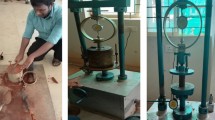Abstract
The performance of a mixture of a forest bye product and cement for the production of storage structure for harvested rainwater was assessed. Three mix ratios of Cement: Gmelina arborea sawdust 3.0:1.0 (specimen A), 2.5:1.0 (specimen B) and 2.0:1.0 (specimen C) were considered. Engineering properties and dimensional stability of the different mix-ratios were monitored from prototypes cylindrical pots and test billet specimens. Possible change in quality of stored rainwater, with time was monitored in all the three cases. Water quality parameters monitored include pH, hardness, total suspended solids, alkalinity, acidity and total dissolved CO2. The tensile stress obtained were 110, 104, and 95 N/mm2, while the compressive strength were 5,000, 3,000, and 2,000 kN for specimens A, B and C respectively. Accelerated aging test showed that sample A were more resistant to deformation, while specimen C were more susceptible to change in structure over time. Similarly, the values of tensile and compressive strength after accelerated aging test increased in the order of specimen A > B > C. Except in specimen C where significant differences in alkalinity and acidity were observed, there were no significant differences in quality of the water stored in the pots after 2 months of storage. The results indicate the suitability of the Gmelina arborea waste as an alternative in constructing water storage structures in rural communities.
Similar content being viewed by others
References
Ajayi, B. (2000). Strength and dimensional stability of cement-bonded flakeboard produced from Gmelina arborea and Leuceana leucophala. Ph.D Thesis, Department of Forestry and Wood Technology, Fed. Univ. of Tech., Akure, Nigeria.
Ajayi, B. (2006). Properties of maize stalk based cement-bonded composites. Forest Product Journal, 56(6), 51–55.
American Society for Testing and Materials (ASTM). (1978). Standard methods of evaluating the properties of wood-based fiber and particle panel materials, ASTM D 1037-78. ASTM, West Conshohocken, PA.
Anon. (2001). 0-DEV contract NO ERBICI and CT9B027, milestone A6: Report A4 January.
Ariyananda, T., & Ratnayaka, N. A. (2006). Improving water security in the Southern province affected by Tsunami through domestic rainwater harvesting system. Paper presented at the International Workshop on RWH, Kandy, Sri Lanka. Available online at http://www.rainwaterharvesting.org. [Accessed Jan. 28, 2007].
Carter, D. C., & Miller, S. (1991). Three years of experience with an on-farm macrocatchment water harvesting system in Botswana. Agricultural Water Management, 19, 191–203.
Fuwape, J. A. (1995). The effect of cement/wood ratio on the strength properties of cement-bonded particleboard’ from spruce. Journal Tropical Forest Production, 1(1), 49–56.
Kossatz, G., Lempfer, K., & Sattler, H. (1994). Wood based panels with inorganic binders. IX. Research and technology. Fraunhofer-Institut Flir Holzforschung (WKI), Braunschweing. S/KP/2907/94, pp. 98–108.
Kwon, H. E., & Geimer, R. L. (1998). Impact of steam pressing variables on the dimensional stabilization of flake board. Forest Production Journal, 48(4), 55–61.
Lahtinen, P. K. (1991). Experiences with cement bonded particle board manufacturing when using a short-cycle press line. In A. A. Moslemi (ed.), Proceedings 2nd int. inorganic bonded wood and fibre composite materials. Forest Prod. Res. Soc. Madison Wis., pp. 32–34.
Li, F., Cook, S., Geballe, G. T., & Burch, W.R. Jr (2000). Rainwater harvesting agriculture, an integrated system for water management on rainfed land in China’s semiarid areas AMBIO. A Journal of the Human Environment, 29(8), 477–483.
Oyagade, A. O. (1990). Effect of cement wood ratio on the relationship between cement-bonded particleboard density and bending properties. Journal of Tropical Forest Science, 2(2), 211–219.
Sekar, I., & Randhir, T. O. (2007). Spatial assessment of conjunctive water harvesting potential in watershed systems. Journal of Hydrology, 343, 39–52.
Shah, A. (1998). Watershed development programmes in India: Emerging issues for environment development perspective. Economic and Political Weekly, 33(26), A-66.
Sharman, W. R., & Vautier, B. P. (1986). Accelerated durability testing of autoclaved wood-fibre-reinforced cement sheet composites. Durability Building Mater, 3, 255–275.
Simatupang, M. H., & Geimer, R. L. (1990). Inorganic binder for wood composities: Feasibility and limitations, In Proceedings of wood adhesive symposium. Forest Prod., Res. Soc. Madison, Wis., pp. 169–176.
The Federal Office of Statistics. (1987). Annual Publication.
World Health Organization (WHO). (2004). Water sanitation and hygiene links to health: Facts and figures. Updated March 2004.
Author information
Authors and Affiliations
Corresponding author
Rights and permissions
About this article
Cite this article
Aladenola, O.O., Ajayi, A.E., Olufayo, A.A. et al. Assessment of Gmelina arborea sawdust–cement-bonded rainwater storage tank. Environmentalist 28, 123–127 (2008). https://doi.org/10.1007/s10669-007-9119-3
Received:
Accepted:
Published:
Issue Date:
DOI: https://doi.org/10.1007/s10669-007-9119-3




